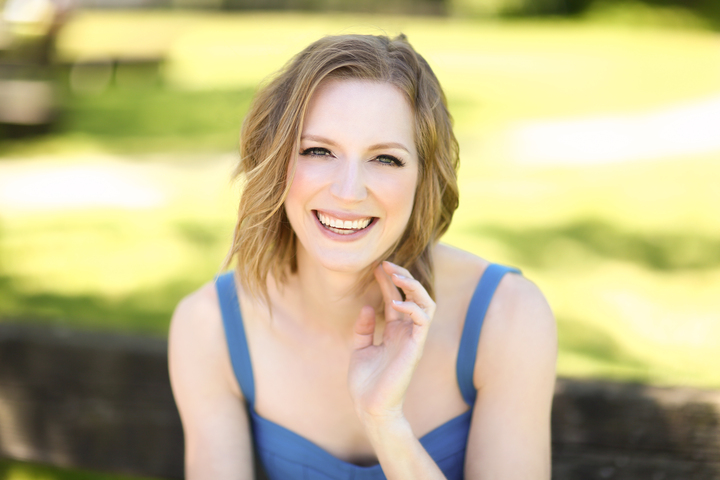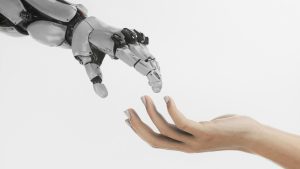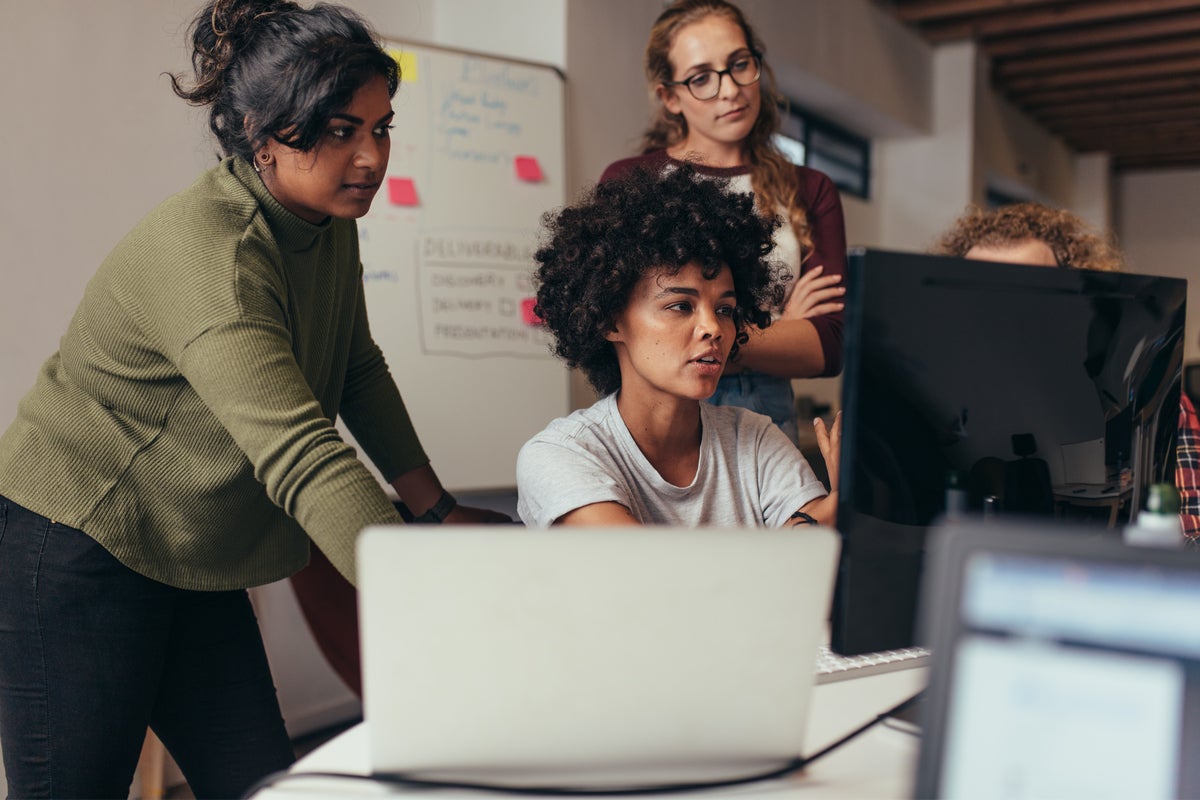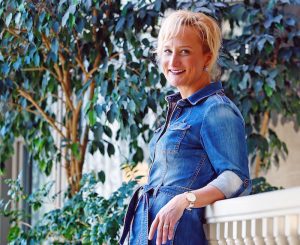[vc_row][vc_column][vc_column_text]Carlyn Loncaric, CEO of VodaSafe and creator of AquaEye, wants one thing: to save lives. As a lifeguard herself, she knows the weight of the responsibility that comes with having people’s lives in your hands. She also knows how helpless one can feel in an instant.
“When you’re working in an outdoor scenario, it’s terrifying,” said Loncaric. “You’re working at a camp or a beachfront and you might not see a child’s head go beneath the surface. You’re always scanning.”
In the event that someone goes under, lifeguards are taught to search in a grid pattern that could take hours. This can be even more difficult when trying to find people in murky water. With each passing minute, the likelihood of a safe retrieval dwindles.
Loncaric knew there had to be a better way.
After conceptualizing an idea for a class project while studying engineering in her undergrad, Loncaric decided to make it a reality and create something with the potential to save lives. Many prototypes later, the AquaEye was born.
Created with the support of the Lifesaving Society of Ontario, AquaEye uses sonar technology to detect people in the water. Loncaric and her team used AI technology to train the device to differentiate between underwater debris and a struggling person. That way lifeguards can bypass vision obstructing elements in the water and get straight to the lost swimmer in minutes.
In 2017 over 465 Canadians died by drowning, and it’s only getting worse. The Lifesaving Society said that drownings in 2020 more than doubled in provinces like Quebec because of warm weather and COVID-19. Since people couldn’t vacation outside of Canada, they took to local lakes and beaches for their fix of summer fun with some unanticipated consequences.
With restrictions still tight across Canada and the warmer weather making a grand entrance this May, the risk of drowning remains high. And according to the Lifesaving Society, most drowning accidents happen in lakes.
“Just because you’re a strong swimmer in a pool [doesn’t mean you’re a strong swimmer in a lake], said Loncaric. “You have no idea what it’s like to be out swimming in the elements.”
The AquaEye has been helpful for more than just lifeguards. Police and firemen are using it for search and rescue missions as well. And though those instances sometimes become recovery missions, Loncaric is glad her technology can help bring closure to families sooner.
For this week’s Women Who Lead, Bay Street Bull spoke with Carlyn Loncaric, Founder and CEO of VodaSafe about how she combined her two passions: lifeguarding and engineering, to save lives.
[vc_text_separator title=”Q&A” color=”custom” style=”double” border_width=”2″ accent_color=”#77e334″]
Tell me about yourself, how you got started with school, and then with lifeguarding, and to creating AquaEye?
I became a lifeguard before I started university and I had a passion for the job. I loved helping people. Like most people who are in that line of work, I love the adrenaline rush when you’re trying to handle an emergency. 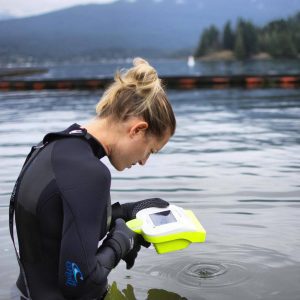

Then I went to school for engineering and through my undergrad degree, I started looking at the world differently. I started to look for problems and solutions and pain points.
Then through lifeguarding and talking to other lifeguards I recognized that when you’re working in an outdoor scenario, it’s terrifying. You’re working at a camp or a beachfront and you might not see a child’s head go beneath the surface. You’re always scanning. If you see heads go under it’s not a big deal—you count to make sure that the next time your eyes cross back over 30 seconds later, they’re surfaced again. But if you don’t see that happen and you’re in a little dark murky lake, the prospect is terrifying.
All we have are goggles and sometimes fins, which allow you to swim a little bit faster. But, when somebody goes missing, you are supposed to do a grid search pattern, which means you put on a pair of goggles and you hold hands with all the other lifeguards and you walk in. You dive and you try to feel around blindly, you surface again and you dive. It’s archaic, it takes a ton of time and it’s very prone to error. It was a nightmare. It was the scariest part of any job of any lifeguard. I recognized that as a pain point and thought there had to be a better way to do this.
Can you go into a more in-depth way of how AquaEye works to prevent drownings and how it can play a role between life or death in those situations?
Absolutely. If you are working at a beachfront or a camp, or near any body of water and somebody comes up yelling to you, “I can’t find my kid.” The first thing you do as a lifeguard is you get the public to get out of the water and you start searching. If you’re trying to search a swimming area, you can imagine most beaches, it could take hours. With Aquaeye you’d grab it, run in the water to waist deep, put it underneath the surface of the water, and pull the trigger. It looks a little bit like a radar gun. You pull the trigger and it starts firing. You can scan your swim area in less than two minutes. It’ll show up on the screen as an X where that person’s located.
So you get an X on the screen, you, or you get another lifeguard to swim 30 meters out in that direction and dive. You can pull that person up. If you can get to them within the first five minutes, you save their lives. If you’re doing that dive pattern, once you’re past that five-minute window, and then it’s starting to lead into an hour, that rescue mission has likely turned into a recovery situation. You can’t give somebody CPR, the brain damage will set in too soon.
It’s that immediacy of being able to locate somebody so that you can get them out of the water and start treating them as soon as humanly possible. That’s what AquaEye allows you to do.
How did you come up with the concept? Was there a moment when you realized that AquaEye could be a solution?
It was a project in the last year of my undergrad degree. You had to invent something and there was a moment [I knew it could be a solution]. I was homesick. It was New Year’s Eve and I was watching the news. A family had lost a four or five-year-old girl. The parents were walking with her and she slipped off the dock and they jumped in right after her and they couldn’t find her. I thought that was tragic. This couldn’t happen anymore. It was at the time this project was taking place. And I thought, there’s got to be something that we can build to help solve that problem. And that’s where the initiative came from. It was in my back pocket. I did a project on it and I kept trying to work on it, but I didn’t launch the company until quite a bit later.
What was it like turning Aquaeye from a project into a real product?
It was a much longer path than I anticipated, with so many prototypes, but also extremely thrilling when it was able to make it to somebody else’s hands. I could see them use it and I realized, Holy cow, this is going to be incredibly powerful. Every single time we put it into a new user’s hand, we hide a diver and they find them in 30 seconds. It looks like magic. It sometimes feels too good to be true. It works so well in that beachfront setting. Surreal would be the word to use.
RELATED: 6 Canadian Businesses Lead by Women in STEM
Were there any difficulties in bringing it to life? I know you said you had prototypes and you are an engineer, which I’m sure helped.
So many problems. It’s gone through so many iterations because when the idea first came about it needed to be a portable device. The type of batteries available on the market at the time could not do what we wanted them to do. The type of screens on the market at the time weren’t good in sunlight.
I needed to do a ton of learning about how to start building a product. It was obstacle after obstacle. That’s why I was only doing it part-time while I was finishing my master’s. Then I got a job with a biomedical engineering company, and it was only until I got laid off from that job that I decided to throw myself a hundred percent into this project. It was a very long road, but worth it.
I forget to think back sometimes, but I overcame hundreds of obstacles. Even the production of it, and then getting people to believe in it. It took me a long time to find a group of people that saw the potential. I ended up teaming up with the Lifesaving Society of Ontario and they were the ones that supported the prototype to production.
There’s always the preconceived notion of women in STEM. Do you feel that that had anything to do with people seeing the value in it?
For me, it was a factor. I was in a class. It was mostly guys and I was timider than I should have been. Looking back, I should have been a lot more vocal and it probably would have gone a lot faster. But I was shy and worried that they were going to knock it down. I had four friends who worked with me while we were in school on the project as a preliminary proof of concept. Afterward, most of them went on to do other things. So. my belief in the product was much stronger than anybody else’s, but I was also the only lifeguard and the only person who had felt firsthand what that adrenaline rush feels like when somebody is in trouble and it’s your job to save their life. You can’t explain that to other people. Being in STEM, especially when I was in school, I was a hundred percent a minority. It takes more nerves to vocalize your thoughts for fear of getting shot down.
You said that back then you were shy and didn’t find your voice. How did you find your voice as a founder and as a woman pitching this product within STEM? How did you find that voice to advocate for why your product was needed?
It was two-fold. When I did partner with Lifesaving Society and they saw value, that was validation that I was onto something real, and that felt good. I’d never been in sales. If you’re in university, everybody knows what entrepreneurship is, but when I was in university, it wasn’t a thing. The idea of the elevator pitch and going out to find investors, I didn’t know any of that stuff. Once I finally got a couple of people believing in it, that built up my confidence. Also getting older and maturing. I recognize that it takes time. You get used to working as a minority.
Learning that should happen way faster, so I try to help and talk to as many young female STEM students as I can. I am a huge advocate for trying to get high school students and middle school students, more excited [about STEM]. It’s something that I hope to spend more time doing later when I’ve got more time.
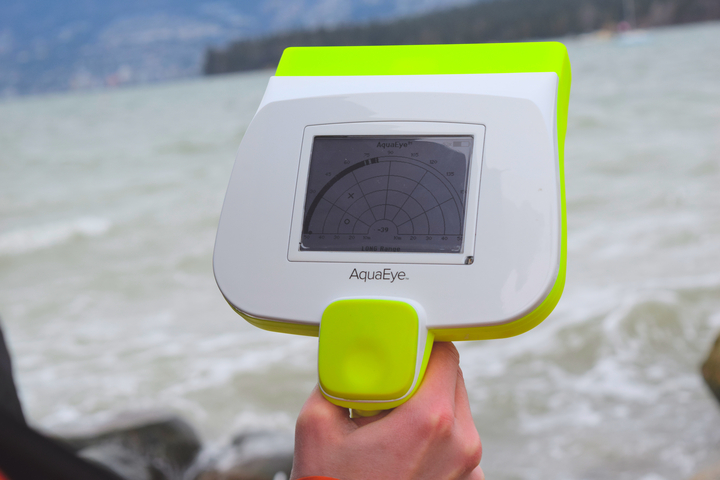

On the other side of that coin is being able to celebrate it becoming a real product that’s being used. What was that experience like seeing the final product out and working?
It’s hard sometimes in a startup to take time to celebrate. You’re always onto the next fire. When the product was first used to successfully locate somebody when a team had been out for about 16 hours looking, that was the first, “Oh my goodness this is real.”
It’s the people around me who are the ones who make me stop and think, “Oh, look at what you’ve done.” But for me, I’m trying to get to the next milestone with the company. I sometimes forget to stop and recognize all that we’ve done. When we save a life, that’ll be the moment where I feel like that’s success for us.
In terms of feedback from people who have used AquaEye, I know I’ve seen some of the reviews and testimonies on the website. What’s that been like?
The feedback’s been incredibly positive from search and rescue, police, fire, anybody handling a missing person search. All you’re trying to do is get closure for a family as fast as possible, and you’re trying to keep your crew safe. They work in horrible dangerous conditions. Being able to give them a unit that can go in the water first and limit the amount of time they have to put themselves at risk by diving is crucial. It also minimizes the waiting. The waiting is probably the equivalent of waiting on a medical test. The worst part is the waiting part. And if instead of having to wait days, weeks, months, you can turn that into minutes or hours that’s huge. It allows the healing process to start sooner for the families and the communities.
These situations that happen, hit a lot of people and also the people out doing the job. It takes a toll on you mentally and physically. We can give them something that they can take anywhere, put in the water within an instant, and that they can all afford because it’s not gargantuan. It’s very accessible. It’s given a lot of entities a manner of doing a job in a way they never thought possible.
For sure. With that, do you have any more innovation coming out of VodaSafe? Are you guys looking at making other products?
Absolutely. That’s why we try to spend as much time with our customers as possible. They’re the ones who are out there doing the work and can keep telling us the things that they want to see and features that we’re putting into software and firmware. We have a maintenance agreement so that we can upgrade these units as we go.
We’re also learning more about different types of applications in scenarios that we never thought about. So yes, we’re an R&D hub.
[AquaEye] is our first product though, so we are trying to concentrate on it and get it out there. The more units out there, the faster that it’s going to be in the right place at the right time to save a life. And that is our number one goal, but yes, we have other innovations coming down the pipeline.
With that, I know you said the AquaEye itself is pretty accessible to be used for any kind of search and rescue crew, whether that be police or lifeguards. What do you hope for in the future of search and rescue and how can AquaEye help?
I want to see drownings come down. Last year, because of the pandemic, people weren’t traveling. People didn’t have as much money to go do certain things. There were way more people out and about. Our drownings across North America went up nearly 50 percent. We get news alerts every day. It’s horrific and it’s tragic and it’s so preventable. My dream is to have AquaEye on every beach and every rescue boat, eventually, even in everybody’s personal boat or cabin. So that if those incidents happen, you have a tool to make a difference. It becomes a learning experience rather than a tragedy that stays with you for the rest of your life. That would be my dream, to bring that drowning rate down. It’s the third leading cause of unintentional death worldwide. We’ve gone through a pandemic. There are so many other things out there that can cause harm. Drowning is something we should be able to get ahead of.
I wasn’t even thinking about drowning, such a tragic circumstance. As you said, people can slip and you don’t know where to search. So I guess that’s where AquaEye comes in and narrows down that grid to get directly to them.
Incredibly quickly. Yes, exactly. The stats point to boating as being an issue, usually in a certain age group and usually with alcohol involved. There are so many stories of people falling off of the boat and that’s it. Whereas, in this situation, if that happens, stick the thing in the water, find them and pull them back out before even 60 seconds have passed. If you imagine opening up your eyes underneath the surface of the water, in most areas of Canada, if you stick your hand out in front of you, you can barely make out your fingertips. Imagine trying to search for somebody who’s gone missing. It is finding a needle in a haystack. So being able to narrow that down in minutes is very powerful.
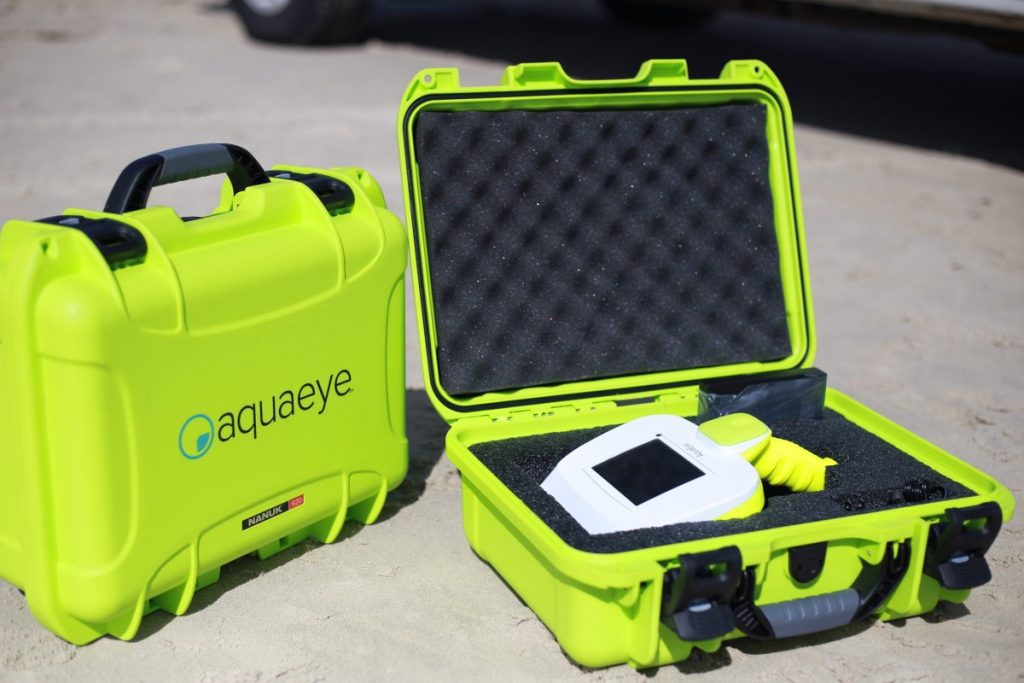

Given all of the stuff that you’ve been able to do to this point in your life. If you were to look back at yourself back when you were in school and coming up with the design of this. What advice would you give to yourself back then?
I would have given myself more courage and told myself not to worry about what other people are going to say. Do what you’re doing faster. Creating a product is a lot of work and it takes teamwork. If I had been a bit braver and a bit more confident, I would have been able to assemble a team sooner and get the product out sooner. And believe in it in a way that I could talk about it publicly. I always believed it would work, but I kept that secret to myself.
Along those same lines, what advice would you give, to other women in STEM as they’re going through that whole schooling process, or even after?
I would say to be brave and to speak up and to let your ideas be heard. This is probably a stereotype, but also something that I’ve experienced through having friends in STEM. The male population seems to be less intimidated to speak up, to be vocal, and to be told that they’re wrong. I’ve seen all my buddies, they can battle through conversations even if they’re in the wrong. They’re still talking which eventually leads the group to get a solution. Keeping quiet does absolutely nothing.
Is there anything that we haven’t touched on regarding yourself or your journey with VodaSafe and Aquaeye that you’d like to touch on?
If people are looking to find out more about us. Find us on our website at vodasafe.ca
Like I said I think it is a cool product. As swimming becomes a bigger thing in the warmer months, drowning is something that people need to be aware of. I think we forget how big water is.
Yes, that’s for sure. I would say as a caution, respect the ocean. Respect the lakes. It’s different from swimming in a pool. Just because you’re a strong swimmer in a pool, or you think you’re a strong swimmer, you have no idea what it’s like to be out swimming in the elements.
[/vc_column_text][/vc_column][/vc_row][vc_row][vc_column][vc_separator color=”custom” accent_color=”#77e334″][/vc_column][/vc_row]
[yikes-mailchimp form=”1″ title=”1″ submit=”SUBSCRIBE”]


